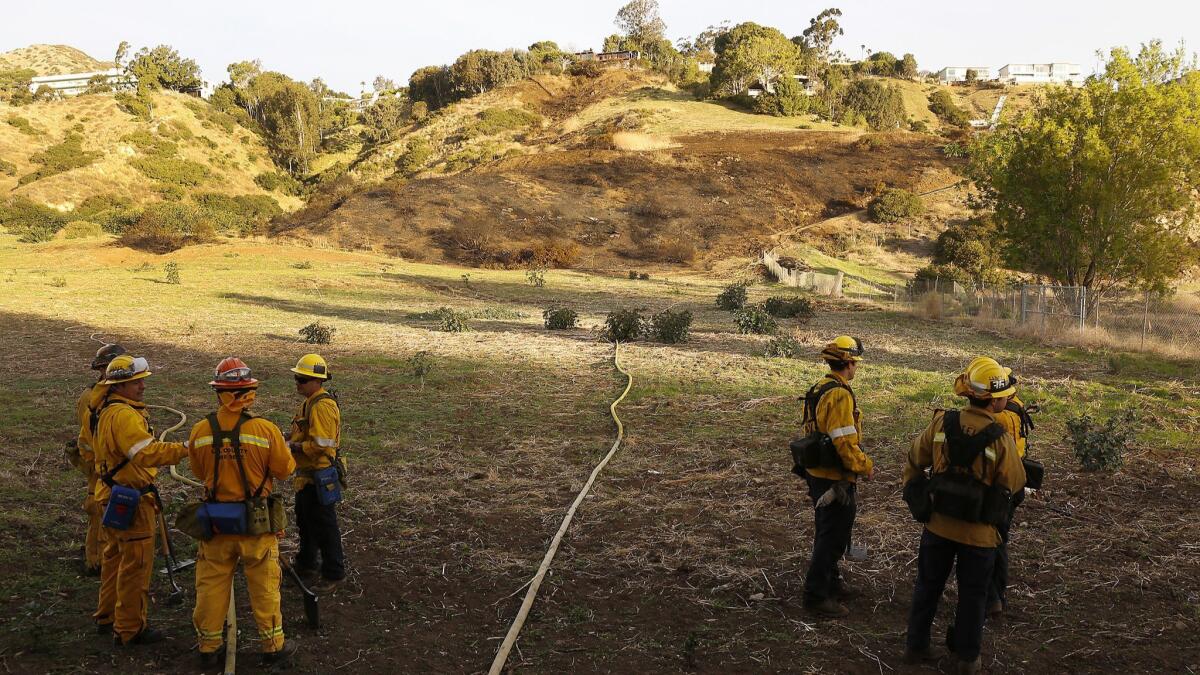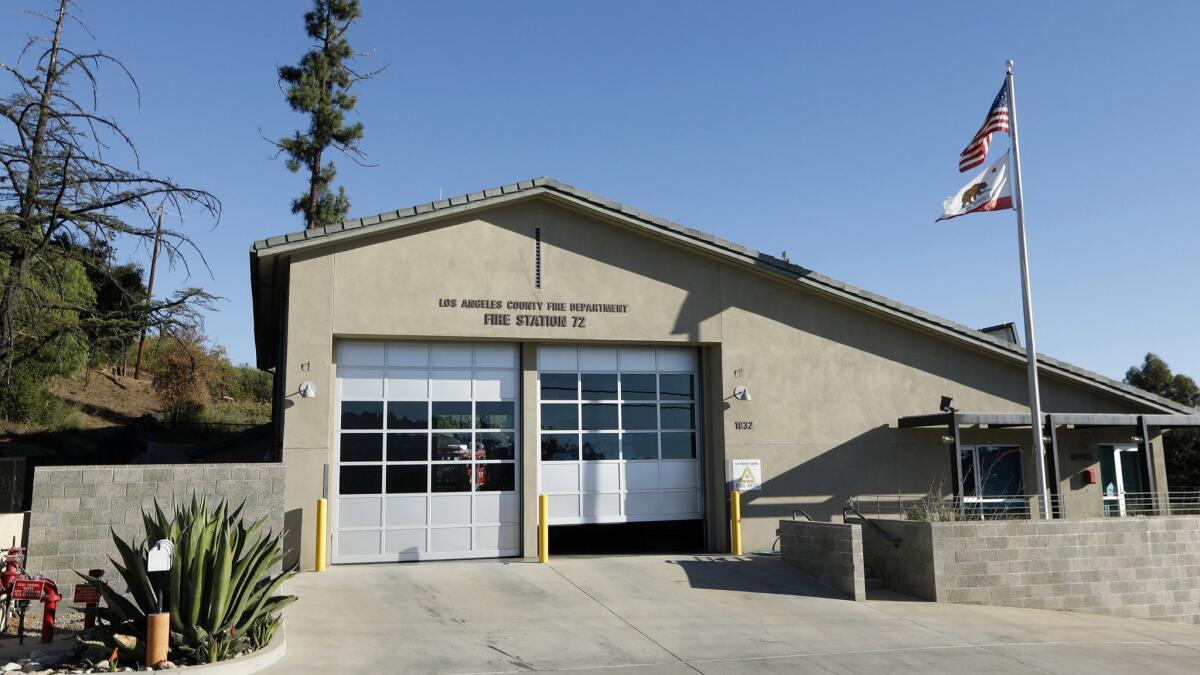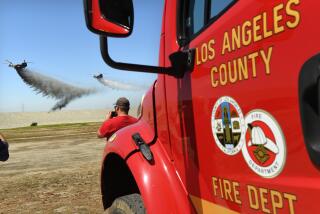L.A. County firefighters earn massive overtime pay, busting budgets and raising questions

Overtime costs at the Los Angeles County Fire Department surged 36% in the last five years, placing some firefighters among the highest-compensated workers in local government.
The increase comes as the department grapples with staffing shortages and several seasons of extreme wildfires. Yet some county officials and outside experts question whether fire commanders are properly managing their $1-billion payroll.
For the record:
7:00 p.m. Oct. 23, 2018This article says millions of dollars spent on unplanned overtime could otherwise have been used for mental health, housing or probation officers. The Fire Department is funded primarily through a special property tax whose revenues cannot be used for other county departments.
The county recently launched an audit of the department’s overtime costs and payroll procedures, though it will be months before that is complete. The Times conducted an analysis of the county payroll database, which lists salaries, overtime and fringe benefits received by about 100,000 employees in the last five years. The results show:
- More than 640 Fire Department workers received at least $100,000 in overtime in the 2017 calendar year. By comparison, there were 28 such employees in the L.A. County Sheriff’s Department, which has twice the number of workers, and 48 in public medical and hospital jobs. No employee in civilian departments of the county recorded overtime that high. Two dozen firefighters made in excess of $200,000 in overtime.
- Fire Department employees represent about a third of the county’s 1,000 highest-paid employees, joining the ranks of surgeons, anesthesiologists and pediatricians who work in its public hospitals. A few made more than the fire chief and the county’s top executive.
- Among county workers who earned overtime, Fire Department employees received the most on average, by a wide margin. They were paid about $49,000 each in overtime last year, while workers in other agencies, including the Sheriff’s Department, were paid about $8,200.
- Overtime accounted for about a third of the average Fire Department employee’s annual pay last year. For other departments, the proportion was around 6%.
The high compensation — in a department that relies so heavily on employees working extra hours — has raised questions among experts who study employment and fire department procedures.
“It’s wrong from a budget perspective. There’s no way that the county should be allowing that to happen,” said Frank Neuhauser, senior research associate at UC Berkeley’s Institute for the Study of Societal Issues and an expert on workplace insurance. “Somebody is not doing scheduling in the right way.”
Top county officials have launched a closer examination of the department’s overtime.
Chief Executive Sachi Hamai, who manages day-to-day operations under the direction of the elected Board of Supervisors, recently asked the county’s auditor-controller to examine the Fire Department’s payroll.
The review began last month and will include interviews with department management about payroll and timekeeping, county spokeswoman Lennie LaGuire said. The goal is to provide “reasonable assurance” that overtime spending complies with guidelines, she said.
Auditors also are expected to review some of the top overtime earners and study whether the Fire Department has a process for receiving some reimbursement when it helps other departments with emergencies such as wildfires or hurricanes.
Such high levels of overtime, which is paid at 1½ times the normal rate, were driven last year by an “inordinate” number of major emergencies, including the Rye, Creek and Thomas fires in Southern California, and assistance provided to authorities in Puerto Rico and Texas after catastrophic hurricanes, according to a statement released by the Fire Department in response to The Times’ inquiries.
The department has also struggled to maintain its staffing targets amid retirements of senior firefighters hired during the 1980s and as its catches up from a slowdown in hiring after the 2008 economic crisis.
“We’re actually developing some strategies so that we reduce our vacancies so we stay within our budget,” Fire Chief Daryl Osby said in a recent interview, adding that it’s fair for the public to take note of the department’s costs. “They should be concerned. It’s their taxpayer funds.”
The highest compensated Fire Department employee last year was Battalion Chief Tom Ray, who works in the department’s fire prevention services bureau. He earned a base salary of $175,000, an amount consistent with his rank, but was paid an additional $283,000 in overtime, bringing his total compensation to about $480,000.
The top overtime earner last year was Capt. Sergio Burciaga, who received about $322,000 in extra pay on top of his $126,000 base salary, pushing his total compensation to $457,000. Payroll records show that he worked 7,449 hours in 2017 — the equivalent of six 24-hour shifts a week all year. He works at Station 105 in Compton.
Reached by phone, Burciaga said he was too busy to be interviewed. Ray did not respond to requests for comment submitted through the department. Several other fire captains and battalion chiefs were paid more than $400,000 last year, the payroll records show.
Apart from the extreme weather in recent years, another constant driver of costs at the county — and many urban fire departments nationwide — is an around-the-clock staffing model, even in neighborhoods that don’t have constant overnight calls.
That’s a particular challenge for the county, which has 170 fire stations spread across more than 2,300 square miles.
The department has more than 4,800 employees and is responsible for emergency incidents in unincorporated areas and 58 cities with a million housing units and 4 million residents. In addition, the department also has 159 lifeguard towers protecting 72 miles of coastline — and a fleet of helicopters and water-rescue machinery.
To maintain what the department considers appropriate staffing, firefighters on average work about 10 24-hour shifts a month, with three or four people required per shift — regardless of the call volume. Sometimes more personnel are deployed proactively when weather conditions make wildfire flare-ups likely, Osby notes.
If firefighters or other emergency staff get sick or take time off for an injury, which can be common, the department asks — or sometimes assigns — colleagues to fill their spots. That’s a practice known as a “recall.”
The top earners volunteer for such assignments, said Battalion Chief Jason Robertson, a department spokesman.
“Those individuals who work that much, they never go home,” he said.

One such firefighter is Capt. Rick Mullen, who leads a team at Station 72, a remote outpost at the western tip of the county, in the canyons north of Malibu. He earned $404,000 last year thanks to more than $260,000 in overtime.
Mullen, a retired U.S. Marine Corps colonel who is also the mayor of Malibu, was paid for working 6,599 hours last year — the equivalent of working five 24-hour shifts a week for the entire year, according to payroll information released by the department under the California Public Records Act.
He said he took extra shifts in many cases voluntarily, in part to avoid being recalled to duty on days when the City Council meets.
“I’m used to working a lot,” he said, recalling his career as a military helicopter pilot, which required long hours in the air and a tour in Afghanistan.
Mullen, who supervises a team of three, said fatigue is a valid concern. But his station isn’t generally disturbed by emergency medical calls at night, allowing sleep — time for which he and other firefighters get paid — but still requiring many hours away from home.
“My wife certainly tells me that I need to be around more,” he said.
Osby and other Fire Department officials say they have controls in place to keep firefighters fresh, despite the increasing pressures on staffing from vacancies and wildfires.
The department has caps on overtime shifts to prevent firefighters from working more than five of their long shifts consecutively or more than 68 overtime shifts in a fiscal year. Records released by the department show those caps are often lifted, however, when the department feels staffing pressure.
“The weather and fire responses over the past few weeks has been unrelenting and one for the record books,” reads one December 2017 memo from fire commanders — obtained under the California Public Records Act — that reinstated the overtime cap after a period of wildfire danger.
The wildfires that have strained the department — both at home and across the state, when it helps other agencies — could continue or perhaps get worse if the climate trends that the state has experienced this decade persist.
Osby said the department is focused on work-rest cycles, even when when dealing with extreme conditions, “but sometimes when we have major incidents, it’s all hands on deck.”
Such a workload can cause strain on firefighters and their families, but it also can reduce the quality of service to the public, the department’s customers, most of whom call for help with emergencies unrelated to fires, experts on fire departments say.
“Are we doing a disservice to our customer, that person who calls us when they have a fire, when their spouse is having a heart attack, when a child has been struck in the street?” said Robert Rielage, a former fire marshal for the state of Ohio who has written about fire department staffing issues nationwide. “They want someone who is fresh, well-trained and who can make good decisions.”
In addition to the strain on workers, overtime also taxes the department coffers.
About 1 in 5 dollars spent on its roughly $1-billion payroll, data show, went to overtime pay. The department exceeded its overtime budget during the 2017 fiscal year — about $166 million — by roughly $46 million, according to a statement released by the department. Overtime spending during the calendar year is comparable: $212 million.
That’s money that could be spent on mental health programs, housing or probation officers.
“This is a cost that requires trade-offs,” Rielage said. “The county has to give up something to pay for the overtime to these firefighters.”
The financial strain traces its roots to the 1980s, when the Fire Department experienced a surge in hiring. That has led to a spate of retirements in recent years, in addition to the normal attrition of about 100 per year, the department said in response to The Times’ inquires.
Another force driving the trend is the financial crisis of 2008, which drained county coffers and led to a downturn in hiring (and fewer experienced firefighters on the job today).
In addition, an unusually high number of firefighters have been placed on injury leave, opening more vacancies, the department said.
Some are skeptical about why such vacancies still exist a decade after the economic downturn, especially given that the department has hired more than 470 new firefighters since 2015.
Neuhauser, the UC Berkeley researcher, welcomed the increased scrutiny from the audit.
“Somebody is not doing scheduling in the right way,” he said. “The explanation that they give you that they have all these vacancies, my guess is they are keeping these vacancies so people can get the overtime.”
In a statement, the Fire Department said it’s working to address the vacancies with what it described as “unprecedented hiring” to counter the surge in retiring firefighters.
The average Fire Department employee’s paycheck is more than 30% overtime pay — a red flag, said Rielage, who served as chief and assistant chief at two city departments in Ohio before retiring.
“If I were doing overtime, and it reached 10% of payroll, I would said say, ‘Hmm, what’s going on here?’” he said.
That’s one question facing the auditors, who are expected to complete their report by December. So far the issue hasn’t raised alarms among the Board of Supervisors.
Only one — Supervisor Janice Hahn — responded to a request for comment.
“We have seen a massive increase in the number of wildfires in California and our Fire Department has sent first responders throughout the state and across the country to assist with natural disasters,” she said in a written statement.
“This has undoubtedly added to overtime pay. However, the auditor-controller is in the middle of reviewing the department’s payroll practices, and we will know more when we see that report.”
Twitter: @stiles
More to Read
Sign up for Essential California
The most important California stories and recommendations in your inbox every morning.
You may occasionally receive promotional content from the Los Angeles Times.











